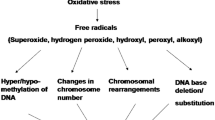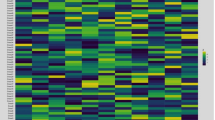Abstract
Cytoplasmic effects have been occasionally implicated in the inheritance of several traits in oilseed rape (Brassica napus L.), including linolenic acid concentration (18:3) in the oil. It is important that these be considered when choosing the direction of cross for producing new breeding populations. To study this phenomenon, a reciprocal cross was made between two genotypes of oilseed rape, Reston and LL09, which differed for their erucic and linolenic acid concentrations in the seed oil. Two DH populations, which were produced by microspore culture from reciprocal F1 plants, were evaluated in the growth room for one generation and in the field at two locations in Southern Ontario in 1993and 1994. Field notes were taken on days to flower, days to maturity,plant lodging, plant height and, seed quality traits. In the growth room study, the phenotypic distribution of 18:3 differed significantly between the two reciprocal DH populations. In the field, significant reciprocal differences between the population means were detected for 18:3,flowering date and protein content in both years and for days to maturity and oil content in 1993 only. To further study the parental lines,chloroplast (cp) and mitochondrial (mt) DNA from parental lines were isolated and subjected to RFLP and RAPD analysis. Several random primers revealed reproducible DNA polymorphism (RAPD) between the parental mt DNA. It is concluded that the direction of cross should be taken into consideration by oilseed rape breeders relying solely on doubled haploids for developing genotypes with modified seed quality traits in Brassica napus L.
Similar content being viewed by others
References
Bannon, C.D., G.J. Breen, J.D. Craske, N.T. Hai & K.L. O'Rourke, 1982. Analysis of fatty acid methyl esters with accuracy and reliability. J Chromatography 247: 71–89.
Bartkowiak-Broda, I. & J. Krzymanski,1983. Inheritance of C18 fatty acid composition in seed oil of zero erucic winter rape Brassica napus L. Proc Inter Rapeseed Conf, Paris, Vol. 1, pp. 477–482.
Beversdorf, W.D., D.J. Hume & M.J. Donnelly-Vanderloo, 1988. Agronomic performance of triazine-resistant and susceptible reciprocal spring canola hybrids. Crop Sci 28: 932–934.
Brim, C.A., W.M. Schutz & F.I. Collins, 1968. Maternal effect on fatty acid composition and oil content of soybeans, Glycine max L. Merr. Crop Sci 8: 517–518.
Chen, J.L., 1988. The inheritance and variation of fatty acids in spring rapeseed (Brassica napus L.) using in vitro techniques and single seed descent. MSc Thesis, Department of Crop Science, University of Guelph, Guelph, Ontario, Canada.
Chen, J.L. & W.D. Beversdorf, 1990. Fatty acid inheritance in microspore-derived populations of spring rapeseed (Brassica napus L.). Theor Appl Genet 80: 465–469.
Davik, J. & W. Heneen, 1996. Fatty acid inheritance in wide reciprocal oilseed crosses(Brassica rapa and B. napus). Acta Agric Scand Sect B Soil and Plant Sci 46: 234–239.
Diepenbrock, W. & R.F. Wilson, 1987. Genetic regulation of linolenic acid concentration in rapeseed. Crop Sci 27: 75–77.
Ekiz, H., A.S. Kiral, A Akçin & L. Simsek, 1998. Cytoplasmic effects on quality traits of bread wheat (Triticum aestivum L.). Euphytica 100: 189–196.
Ekiz, H. & C.F. Konzak, 1991. Nuclear and cytoplasmic control of anther culture response in wheat: III. Common wheat crosses. Crop Sci 31: 1432–1436.
Edwards, K., C. Johnstone & C. Thompson, 1991. A simple and rapid method for the preparation of the plant genomic DNA for PCR analysis. Nucl Acids Res 19: 1349.
Gomez, K.A. & A.A. Gomez, 1984. Statistical Procedures for Agricultural Research. 2nd edition. John Wiley & Sons, New York, USA.
Jakkula, L.R., D.A. Knauft & D.W. Gorbet, 1997. Inheritance of a shriveled seed trait in peanut. J Heredity 88(1): 47–51.
Kemble, R.J., 1987. A rapid, single leaf, nucleic acid assay for determining the cytoplasmic organelle complement of rapeseed and related Brassica species. Theor Appl Genet 73: 364–370.
Lonsdale, D.M. & J.M. Grienenberger, 1992. The mitochondrial genome of plants. In: R.G. Herrmann (Ed.), Plant Gene Research. Cell Organelles. Chapter 6. Springer Verlag, Wien, New York.
Lorenz, M., A. Weihe & T. Börner, 1997. Cloning and sequencing of RAPD fragments amplified from mitochondrial DNA of malesterile and male-fertile cytoplasm of sugar beet (Beta vulgaris L.). Theor Appl Genet 94: 273–278.
Makaroff, C.A. & J.D. Palmer, J.D. 1988. Mitochondrial DNA rearrangements and transcriptional alterations in the male-sterile Ogura radish. Mol Cell Biol 8: 1474–1480.
Mikami, T., M. Sigiura & T. Kinoshita, 1984. Molecular heterogeneity in mitochondrial and chloroplast DNAs from normal and male sterile cytoplasm in sugar beets. Curr Genet 8: 319–322.
Miller, R.L., R.M. Shibbles, E.G. Hammond & D.E. Green, 1996. Effect of unique cytoplasm in reciprocal crosses of soybeans. Crop Sci 36: 1196–1206.
Oettler, G. & D.J. Mares, 1994. Falling number and alpha-amylase activity in developing grain of alloplasmic hexaploid wheat. Plant Breed 112: 47–52.
Palmer J.D. & L.A. Hebron, 1987. Unicircular structure of the Brassica hirta mitochondrial genome. Curr Genet 11: 565–570.
Pleines, S. & W. Friedt, 1989. Genetic control of linolenic acid concentration in seed oil of rapeseed (Brassica napus L.). Theor Appl Genet 78: 793–797.
Polsoni, L., L.S. Kott & W.D. Beversdorf, 1988. Large scale microspore culture technique for mutation, selection studies in Brassica napus L. Can J Bot 66: 1681–1685.
Powell, W., W.T.B. Thomas, D.M. Thompson, J.S. Swanston & R. Waugh, 1992. Association between rDNA alleles and quantitative traits in doubled haploid populations of barley. Genetics 130: 187–194.
Rajcan, I., 1996. Molecular and Breeding Studies of Doubled Haploids Segregating for Linolenic Acid Levels in Brassica napus L. Ph.D. Thesis, Department of Crop Science, University of Guelph, Guelph, Ontario, Canada.
Rajcan I., K.J. Kasha, L.S. Kott & W.D. Beversdorf, 1999. Detection of molecular markers associated with linolenic and erucic acid levels in spring rapeseed (Brassica napus L.). Euphytica 105: 173–181.
Rajcan, I., Kott, L.S., Beversdorf, W.D. and Kasha, K.J. 1997. Performance of doubled haploid populations segregation for linolenic acid levels in spring rapeseed. Crop Sci 37: 1438–1442.
Ramsey, L.D., J.E. Bradshaw & M.J. Kearsey, 1994. The inheritance of quantitative traits in Brassica napus ssp. rapifera (swedes): augmented triple test cross analysis of yield. Heredity 73: 84–91.
Rawat, D.S., 1992. Analysis of reciprocal differences in Indian mustard. Acta Agron. Hungarica 41 (3-4): 227–233.
Sane, A.P., P. Seth, S.A. Ranade, P. Nath & P.V. Sane, 1997. RAPD analysis of isolated mitochondrial DNA reveals heterogeneity in elite wild abortive (W) cytoplasm in rice. Theor Appl Genet 95: 1098–1103.
Seka, D. & H.Z. Cross, 1995. Xenia and maternal effects on maize kernel development. Crop Sci 35: 80–85.
Siegel, S., 1956. Non-Parametric Statistics for the Behavioural Sciences, pp. 121–124. McGraw-Hill Book Company. New York, Toronto, London.
Singh, B.B. & H.H. Hadley, 1968. Maternal control of oil synthesis in soybean, Glycine max L. Merr. Crop Sci 8: 622–625.
Thomas, P.M. & Z.P. Kondra, 1973. Maternal effects on the oleic, linoleic and linolenic acid content of rapeseed oil. Can J Pl Sci 53: 221–225.
Van Deynze, A.E., B.S. Landry & K.P. Pauls, 1995. The identification of restriction length polymorphisms lined to seed colour genes in Brassica napus. Genome 38: 534–542.
Vedel, F., P. Chetrit, C. Mathieu, G. Pelletier & C. Primard, 1986. Several different mitochondrial DNA regions are involved in intergeneric recombinations in Brassica napus cybrid plants. Curr Genet 11: 17–24.
Wang, M. & I.L. Goldman, 1997. Transgressive segregation and reciprocal effect for free folic acid content in a red sugar beet (Beta vulgaris L.) population. Euphytica 96: 317–321.
Weber, S., W. Luchs & W. Friedt, 1995. Application of microspore culture in Brassica napus crosses involving resynthesized rapeseed. Cruciferae Newsletter 17: 40–41
Welsh, J. & M. McClelland, 1990. Fingerprinting genomes using PCR with arbitrary primers. Nucleic Acids Res 18: 7213–7218.
Wilcox, J.R., 1985. Breeding soybeans for improved oil quality and Quantity, pp. 380–386. In: R. Shibles (Ed.), Proc World Soybean Res Conf, 3rd, Ames, IA, 12 Aug. 1984. Westview Press. Boulder, CO.
Williams, J.G.K., A.R. Kubelik, K.J. Livak, J.A. Rafalski & S.V. Tingey, 1990. DNA polymorphism amplified by arbitrary primers are useful genetic markers. Nucleic Acids Res 18: 6531–6535.
Author information
Authors and Affiliations
Rights and permissions
About this article
Cite this article
Rajcan, I., Kasha, K., Kott, L. et al. Evaluation of cytoplasmic effects on agronomic and seed quality traits in two doubled haploid populations of Brassica napus L.. Euphytica 123, 401–409 (2002). https://doi.org/10.1023/A:1015057923578
Issue Date:
DOI: https://doi.org/10.1023/A:1015057923578




